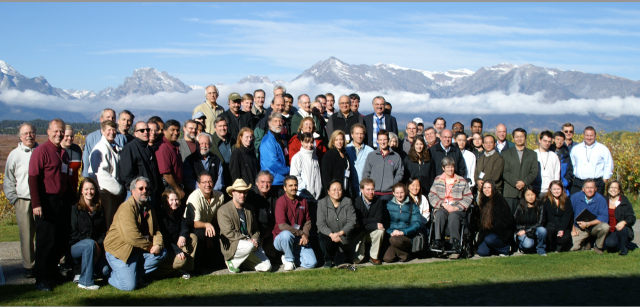Imaging in 2020 V: Imaging Theragnostics
September 23-27, 2007

Program Chairs: Robert Gillies and Warren Warren
Organizers: Thomas Meade and Daniel Sullivan
Session I: Imaging Theragnostics
Chair: Jeffrey Evelhoch, Amgen
The promises and realities of imaging as a biomarker to accelerate drug development
Timothy McCarthy, Pfizer
Antibodies: The ideal diagtherapeutic
Andrew Raubitschek, City of Hope
Session 3: Quantitative Image Analysis
Chair: Jeffrey Duerk, Case Western Reserve University
Algorithms for quantitative assessment of pediatric brain MRI
Simon Warfield, Children’s Hospital Boston
Cryo-imaging of whole mice & counting single fluorescently labeled cells
David Wilson, Case Western Reserve University
Session 5: Horizons of Hyperpolarization
Chair: Joseph Ackerman, Washington University
Recent advances with PHIP
Elena Vinogradov, Beth Israel Deaconess Medical Center
Diffusion-MRI of lungs and emphysema with hyperpolarized Helium-3
Mark Conradi, Washington University
Can hyperpolarized carbon be used for quantitative metabolic flux measurements?
Matthew Merritt, University of Texas Southwestern
Hyperpolarized C-13 metabolic probes for the detection& characterization of prostate cancer prior to and after therapy
John Kurhanewicz, UC San Francisco
Session 7: Activatable Agents
Chair: Tom Meade, Northwestern University
PARACEST MRI contrast agents that detect enzyme activities
Marty Pagel, Case Western Reserve University
MRI-guided cancer therapy: Gadolinium-encapsulated carbon nanostructures for theragnostics
Lon Wilson, Rice University
Session 9: Imaging Hypoxia
Chair: Robert Gillies, University of Arizona
Quantitatve assessment of tumor hypoxia by electron paramagnetic resonance
Murali C. Krishna, National Institutes of Health
Testing the clinical implications of hypoxia imaging
Kenneth Krohn, University of Washington
Session 2: Targeting the Cell Surface
Chair: Henry Van Brocklin, UC San Francisco
Design, synthesis & biological evaluation of novel multimeric, heterovalent ligands for the detection and treatment of cancer
Victor Hruby, University of Arizona
Targeted molecular imaging using radiolabeled peptides: A random and rational approach
Julie Sutcliffe, University of California, Davis
Session 4: Chemistry of Optically Active Proteins
Chair: Chris Contag, Stanford University
Novel nonlinear optical contrast for functional imaging in tissue
Martin Fischer, Duke University
Chemistries of fluorescent proteins for in vivo sensing
Robert Campbell, University of Alberta
Session 6: Ultrasound, Photoacoustics & Optical Imaging
Chair: Warren Warren, Duke University
Microultrasound in the land of bioresearch
Stuart Foster, University of Toronto
Ultrasound beyond imaging
Thomas Nelson, UC San Diego
Session 8: New Chemistries for Contrast Agents
Chair: Dean Sherry, UT Dallas / UT Southwestern
Advances in PARACEST MR imaging
Robert Lenkinski, Beth Israel Deaconess Medical Center
Engineering emissive europium complexes for imaging and sensing
David Parker, Durham University (UK)
Keynote Address
The social and economic value of medical research
Kevin Murphy, University of Chicago
